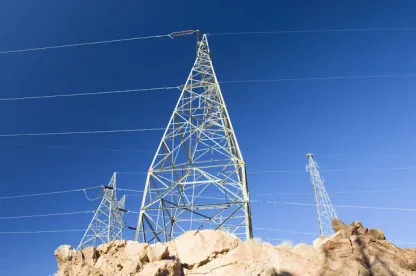Against the backdrop of speculation concerning Tesla’s upcoming announcement which is widely anticipated to be a distributed energy storage product, and with continuing industry reports of a burgeoning domestic and international market for both grid-connected and behind the meter energy storage, on April 23, 2015 the Colorado Public Utilities Commission (CPUC) spent the afternoon hearing from a wide variety of stakeholders about the challenges and opportunities presented by distributed energy storage.
The discussion came in the context of the CPUC’s ongoing proceedings related to retail renewable distributed generation and net metering (Proceeding No. 14M-0235E). Beginning in June, 2014, the CPUC has held a series of panel discussions focused on different aspects of the distributed energy resource and net metering issue. In addition to discussing distribution system design and ancillary benefits associated with solar photovoltaic systems, solar PV system sizing and panel orientation, and minimum billing issues, the CPUC’s most recent panel discussion delved into the current costs and economics of energy storage for residential, commercial and industrial customers, the anticipated growth rate for distributed energy storage in Colorado, the relationship between energy storage and net metering, and the regulatory changes needed to encourage energy storage projects.
Ben Kaun, Senior Project Manager in the Electric Power Research Institute’s (EPRI) Energy Storage Program, provided an overview of the varying roles energy storage systems can play including functioning as a capacity resource, supporting the grid through flexible ramping, voltage control, and renewable integration, and providing grid reliability and resiliency services. Mr. Kaun emphasized that that traditional metric of the Levelized Cost of Energy (LCOE) is not suitable when evaluating energy storage applications; rather, a lifetime net present value approach should be employed to consider the full range of costs and benefits associated with energy storage. Mr. Kaun explained that when evaluating behind-the-meter energy storage it is important to consider the perspective of both the customer and the utility or grid operator since the incentives for energy storage and the potential uses and benefits of storage systems may differ between these two perspectives. A customer whose primary interest is using a storage system to take advantage of time-of-use rates may not be aligned with a utility that is interested in using aggregated energy storage systems to manage overall load. From EPRI’s perspective, the tools needed to understand the value of energy storage and its grid impacts are still under development; however, ongoing industry efforts, including California’s substantial commitment to energy storage deployment, should lead to rapid maturation of energy storage applications over the next five years.
Ryan Hanley of SolarCity spoke on behalf of several distributed solar stakeholders. Mr. Hanley updated the Commissioners on the general trend toward declining battery prices which is expected to continue for the foreseeable future. Describing SolarCity as bullish on energy storage, Mr. Hanley stated that the company expects that by 2020 all of its solar PV installations will include a storage component. Mr. Hanley emphasized, however, that policies are needed which recognize the full range of benefits distributed storage can provide and allow participants to realize the revenues associated with those benefits. Furthermore, widespread deployment of smart inverters is needed to fully recognize the multiple benefits of distributed storage. While focused primarily on the potential of distributed generation paired with distributed storage, Mr. Hanley agreed that there is no one “sweet spot” in terms of energy storage system size, location, and technology; rather, a diverse portfolio of distributed and grid-level storage is needed and should be considered as part of utilities’ planning processes.
Commissioner Glenn Vaad asked the question that many people seemed interested in, especially given the context of the proceeding in which this discussion was taking place — isn’t distributed energy storage the anti-thesis of net energy metering? Mr. Hanley acknowledged that customer-sited storage could result in no distributed generation being sent to the grid and, therefore, no need for net metering; however, he opined that storage simply provides another set of flexible benefits in addition to the potential load modification benefits of distributed solar PV.
Sky Stanfield spoke on behalf of the Interstate Renewable Energy Council (IREC) and presented specific regulatory recommendations from IREC’s February, 2015 report, “Deploying Distributed Energy Storage: Near-Term Regulatory Considerations to Maximize Benefits.” IREC recommended that the CPUC consider appropriate rate designs, including time of use rates and demand charges, to incentivize customer behavior related to energy storage. Consistent with comments from other speakers, Ms. Stanfield explained the importance of energy storage “benefit stacking” and the need to open-up markets for demand response and ancillary services that can be provided by aggregated energy storage systems. This, however, is a particular challenge in Colorado where there is no ISO or RTO to facilitate such market participation. IREC also recommended that the CPUC ensure that both interconnection and net metering policies and standards are clear and make sense when applied to distributed energy storage systems. Similar to a point made by Mr. Hanley, Ms. Stanfield encouraged the CPUC to integrate consideration of energy storage into the broader utility distribution system planning process. IREC’s final recommendation focused on the importance of a coordinated approach to safety in the context of industry codes and standards for energy storage.
Throughout the discussion, the CPUC Commissioners probed into the various policy and practical considerations associated with distributed energy storage and its potential applications in Colorado. While Colorado presently lacks the legislative mandate that is driving the deployment of energy storage in California, the Commissioners seemed most interested in identifying how regulatory initiatives could help build Colorado’s experience base related to energy storage. Chairman Joshua Epel framed the challenge as how best to “leap-frog” distributed energy storage in Colorado? Based on the panel discussion, it appears the answer will be a combination of regulatory incentives, creative approaches to realizing the system and monetary benefits associated with energy storage, and patience as technologies mature and utilities, customers, and storage providers gain more experience with deployed energy storage systems.




 />i
/>i
